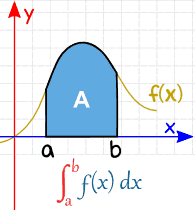By using the properties of definite integrals, evaluate the integral: \(∫_0^π log(1+cosx)dx\)
Solution and Explanation
Let I=\(∫_0^π log(1+cosx)dx....(1)\)
\(⇒I=∫_0^π log(1+cos(π-x))dx ......... (∫_0^aƒ(x)dx=∫_0^aƒ(a-x)dx)\)
\(I=∫_0^π log(1+cosx)dx....(2)\)
\(Adding(1)and(2),we obtain\)
\(2I=∫_0^π {log(1+cosx)+log(1-cosx)}dx\)
\(⇒2I=∫_0^π log(1-cos^2x)dx\)
\(⇒2I=∫_0^π logsin^2xdx\)
\(⇒2I=2∫_0^π logsinxdx\)
\(⇒I=∫_0^π logsinxdx...(3)\)
\(sin(π-x)=sinx\)
\(∴I=2∫_0^\frac{π}{2}logsinxdx...(4)\)
\(⇒I=2∫_0^\frac{π}{2} logsin(\frac{π}{2}-x)dx=2∫_0\frac{π}{2}logcosxdx...(5)\)
\(Adding(4)and(5),we obtain\)
\(2I=2∫_0^\frac{π}{2}(logsinx+logcosx)dx\)
\(⇒I=∫_0^\frac{π}{2}(logsinx+logcosx+log2-log2)dx\)
\(⇒I=∫_0^\frac{π}{2}(log2sinxcosx-log2)dx\)
\(⇒I=∫_0^\frac{π}{2}logsin2xdx-∫_0\frac{π}{2}log2dx\)
\(Let 2x=t 2dx=dt\)
\(When x=0,t=0 and when x=\frac{π}{2},π=\)
\(∴I=\frac{1π}{2}∫_0^π0logsintdt-\frac{}{2}log2\)
\(⇒I=\frac{1πI}{2}-\frac{}{2}log2\)
\(⇒\frac{I}{2}=-\frac{π}{2}log2\)
\(⇒I=-πlog2\)
Top Questions on integral
- Evaluate the integral: \[ \int \frac{\sin(2x)}{\sin(x)} \, dx \]
- Find the value of the integral: \[ \int_0^\pi \sin^2(x) \, dx. \]
- Evaluate the integral: $$ \int_0^{\pi/4} \frac{\ln(1 + \tan x)}{\cos x \sin x} \, dx $$
- Evaluate the integral \( \int_0^1 \frac{\ln(1 + x)}{1 + x^2} \, dx \)
- Let $ f(x) $ be a positive function and $I_1 = \int_{-\frac{1}{2}}^1 2x \, f\left(2x(1-2x)\right) dx$ and $I_2 = \int_{-1}^2 f\left(x(1-x)\right) dx.$ Then the value of $\frac{I_2}{I_1}$ is equal to ____
Questions Asked in CBSE CLASS XII exam
- Find the point on the line \( \frac{x-1}{3} = \frac{y+1}{2} = \frac{z-4}{3} \) at a distance of \( \sqrt{2} \) units from the point \( (-1, -1, 2) \).
- CBSE CLASS XII - 2025
- Distance between point and line
- You are Radha/Rahul Batheja, a Class XII student and a member of the school magazine editorial board. Write a comprehensive report detailing the activities undertaken by students as part of Environment Awareness Week, including description of the event, participation details, and overall impact of these activities on the school community.
- CBSE CLASS XII - 2025
- Report Writing
- Suppose there are only three firms in an imaginary economy, viz. X, Y and Z. During a year, the following transactions took place in the economy:
(I) Firm X sold goods worth ₹ 20,000 to Firm Y and ₹ 12,000 to Firm Z.
(II) Firm Y sold goods worth ₹ 11,000 to Firm X and ₹ 35,000 to Firm Z.
(III) Firm Z sold goods worth ₹ 57,000 to households for final consumption.
On the basis of the given transactions, calculate the value of Gross Domestic Product at Market Price (GDP\textsubscript{MP}) in the economy.- CBSE CLASS XII - 2025
- National Income Accounting
- Complete the following reactions by writing the structural formulae of ‘A’ and ‘B’:
(i) CH$_3$CH=CH$_2$ + HBr $\xrightarrow{\text{Peroxide}}$ ‘A’ $\xrightarrow{KOH}$ ‘B’
(ii) CH$_3$CH$_2$CHCl + alc. KOH $\xrightarrow{\Delta}$ ‘A’ $\xrightarrow{\text{H}_2\text{O}}$ ‘B’ (Main product)- CBSE CLASS XII - 2025
- Hydrocarbons
- Calculate emf of the following cell at 25°C: \[ \text{Zn}(s) \, | \, \text{Zn}^{2+} (0.1M) \, || \, \text{Cd}^{2+} (0.01M) \, | \, \text{Cd}(s) \] Given: \[ E^\circ_{\text{Zn}^{2+}/\text{Zn}} = -0.40 \, \text{V}, \quad E^\circ_{\text{Cd}^{2+}/\text{Cd}} = -0.76 \, \text{V}. \]
- CBSE CLASS XII - 2025
- Electrochemistry
Concepts Used:
Definite Integral
Definite integral is an operation on functions which approximates the sum of the values (of the function) weighted by the length (or measure) of the intervals for which the function takes that value.
Definite integrals - Important Formulae Handbook
A real valued function being evaluated (integrated) over the closed interval [a, b] is written as :
\(\int_{a}^{b}f(x)dx\)
Definite integrals have a lot of applications. Its main application is that it is used to find out the area under the curve of a function, as shown below:
